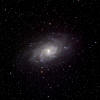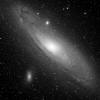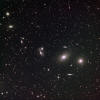These Island Universes once thought to be simply "spiral" nebula of our own
Milky Way are now known to be millions and in many cases, billions of light
years distant. Many of these images were taken when amateur astronomical CCD
imaging was still new using a relatively new endeavor. As I take new images I'll
replace the older ones.
|
M33 Color image with STL-4020, FSQ 106, LRGB,
60,30,30,30 Processed with CCD Stack and Photoshop. Click on the thumbnail
for a larger image.
|
 |
| Everyone's favorite Spiral galaxy and why not? It is bright
beautiful, easy to find and well plaeed for imaging for most Northern
Hemisphere observers. This is 45 minutes with ST-7 and a 5inch f6 AP
Refractor |
 |
| M63 aka as the Sunflower glalxy. This B&W image was taken at
the Texas Star Party in 1998 with an early model ST-7 and an AP 5 inch f6
refractor |
 |
| M64 aka as the Black eye Galaxy again Texas Star Party 1998
early model ST-7 and AP 5inch refractor |
 |
| M81, taken along time ago with an ST-6 and a 11 inch SC at
f6.3. |
 |
| M82 again taken a long time ago with an ST-6 and a 11 inch
SC at f6.3. Just trying to put the galaxy on the small chip was a challenge |
 |
| M100 is a small face on spiral of the Grand Design. It is
part of the Virgo Cluster of Galaxies |
 |
| M101 is a large face on Spiral Just above the Handle of the
Big Dipper |
 |
| M104 is known as the Sombrero galaxy. This is an almost edge
on with a very dark dust lane. M104 has a a very large bulge that was
beautifully imaged by HST a few years ago |
 |
| M105 is one of this close triplet |
 |
| M106 |
 |
| Leo Triple M65 M66 and |
 |
| Ngc253 color image C14 ST-10 |
 |
| NGC4565 is a beautiful edge on Spiral. |
 |
| NGC 5128 is an active galaxy on Centaurus. It maybe a result
from a collision and the prominent dust lane was a remnant from it |
 |
| M31 the Great Andromeda galaxy. This is the furthest object
that can be easily seen with the unaided eye. Many observers have seen this
small smudge in Andromeda and turned their binoculars to it and seen a
spectacular site. Andromeda is larger than the full moon and with binoculars
it really shows it shape. With a telescope the narrower field actually
detracts from the aesthetic but it does really bring out the object. |
 |
| Markarian's Chain Anchored by the large galaxies M84 and M86
This Chain of galaxies forms a unique "asterism" of galaxies that is useful
in navigating the Virgo Cluster. It is the brightest gruping of galaxies in
the night sky. In this image taken with the STL-4020 and TAK FSQ106N there
are over 30 galaxies. The Asterism of M84, M86, NGC4387 and NGC4388 make up
"the face". M84 and 86 are the eyes. This color image was taken over 2
nights and is composed of about 5 hours of imaging. The red images were very
noisy due to high clouds thus the red glow on the edges. |
 |















